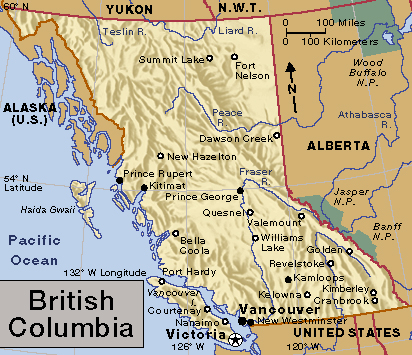Kitimat << KIHT ih mat >>, British Columbia (pop. 8,236), is a community that was carved out of low, wooded land at the head of Douglas Channel on the North Pacific Coast. Kitimat lies 400 miles (640 kilometers) north of Vancouver. The Haisla First Nation community of Kitamaat Village is nearby.

In 1951, the Aluminum Company of Canada (later called Alcan Inc.) started building a huge new aluminum smelter and the community of Kitimat to house workers’ families. The company picked this site because of its harbor and the area’s abundance of water to provide inexpensive hydroelectric power. The company built Kenney Dam east of the mountains to reverse the eastward flow of the Nechako River and created a 350-square-mile (906-square-kilometer) reservoir. A 10-mile (16-kilometer) tunnel through the Coast Mountains carries the water to the western side of the mountains. There, the water drops to a power plant built inside the mountains at Kemano, 50 miles (80 kilometers) south of Kitimat. Power lines carry the power generated at Kemano to Kitimat.
In 1995, Alcan stopped work on a second tunnel because of controversy about the tunnel’s impact on the environment and on the fishing industry. In 2007, Rio Tinto acquired Alcan and merged its aluminum operations into a company called Rio Tinto Alcan.
Kitimat was scientifically planned. The residential area is east of the channel head, and the industrial area is southwest of the head. Kitimat is a district municipality. It was incorporated in 1953. The municipality has a mayor-council form of government.
